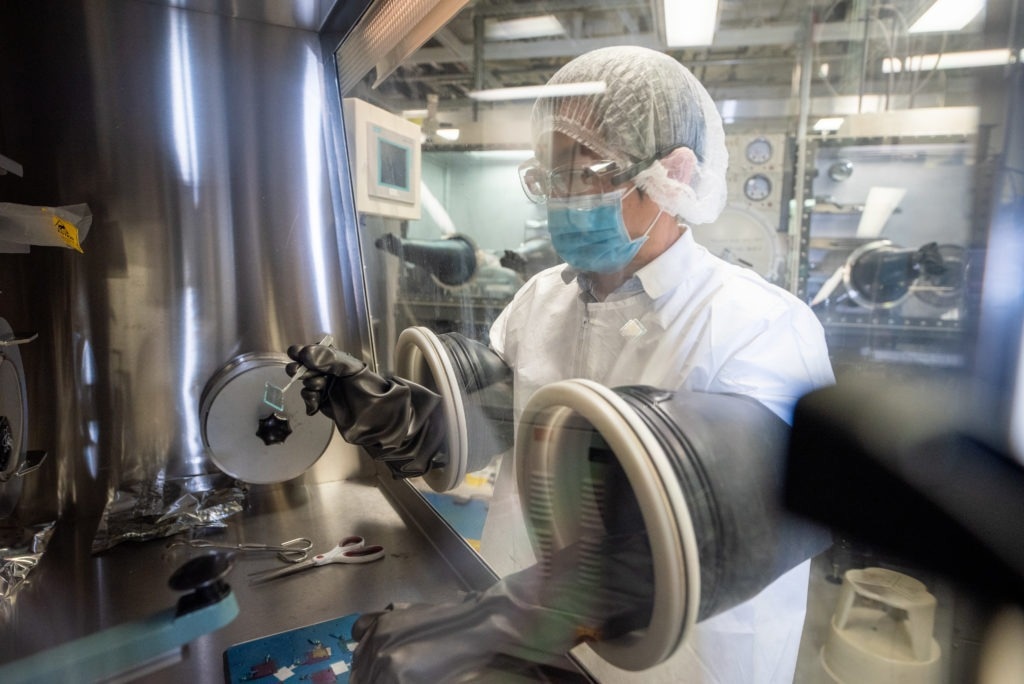The way that plants transport solar energy over relatively long distances before powering chemical reactions can be mimicked by a comparatively new type of semiconductor. This semiconductor is stacked on top of a mirror-like structure, and the method might one day increase the effectiveness of solar cells.
 Bin Liu, a postdoctoral researcher in electrical and computer engineering, loads the mirror-like photonic structure into the glove box—on the way to adding the light detector on top of the structure. Image Credit: Silvia Cardarelli, Electrical and Computer Engineering, University of Michigan.
Bin Liu, a postdoctoral researcher in electrical and computer engineering, loads the mirror-like photonic structure into the glove box—on the way to adding the light detector on top of the structure. Image Credit: Silvia Cardarelli, Electrical and Computer Engineering, University of Michigan.
Energy transport is one of the crucial steps for solar energy harvesting and conversion in solar cells. We created a structure that can support hybrid light-matter mixture states, enabling efficient and exceptionally long-range energy transport.
Bin Liu, Study First Author and Postdoctoral Researcher, Electrical and Computer Engineering, University of Michigan
Leakage currents are one of the ways that solar cells waste energy. It occurs in the area of the solar cell where the positively charged “holes” and negatively charged electrons produced by light absorption are separated at a junction between two semiconductors to produce an electrical current.
Since the junction area of a normal solar cell is the same size as the area that gathers light, electrons and holes do not have to travel very far to get to it. However, the leakage currents’ energy loss is a disadvantage.
The massive “antenna complexes” in chloroplasts that capture light and the relatively smaller “reaction centers,” where the electrons and holes are separated for use in the creation of sugar, help nature reduce these losses in photosynthesis.
The excitons, also known as electron-hole pairs, are extremely challenging to move across long distances in semiconductors.
According to Liu, the highly organized structures of photosynthetic complexes allow them to accomplish this; however, human-made materials are usually too flawed.
The new technology avoids this issue by not completely turning photons into excitons; instead, they retain some light-like characteristics. A polariton is a mixture of photons, electrons, and holes.
Even further than the distances that excitons traverse inside leaves, the energy can quickly cross quite significant distances of 0.1 millimeters in polariton form, thanks to its light-like characteristics.
By placing the thin, light-absorbing semiconductor on top of a photonic structure that resembles a mirror, the researchers illuminated it to produce the polaritons. This part of the apparatus collects light energy over a wide region in a manner similar to the antenna complex in chloroplasts.
The semiconductor directed the polaritons to a detector, which changed them into electric current with the aid of the mirror-like structure.
The advantage of this arrangement is that it has the potential to greatly enhance the power generation efficiency of conventional solar cells where the light gathering and charge separating regions coexist over the same area.
Stephen Forrest, Peter A. Franken Distinguished University Professor of Engineering, University of Michigan
Although the team is confident that energy is being transported through their system, they are not entirely convinced that the energy is constantly traveling as a polariton. It is possible that on the way to the detector, the photon sort of surfs over many excitons.
The subject of creating effective light-gathering devices that can capture the energy transfer akin to photosynthesis is also left for future research.
The Army Research Office and Universal Display Corporation jointly funded the study, and the latter has licensed the technology and applied for a patent. Financial interests in Universal Display Corp. are held by Forrest and the University of Michigan.
In addition, Forrest holds the positions of Paul G. Goebel Professor of Engineering, and a Professor of Electrical Engineering, Computer Science, Material Science, and Physics.
The device was made in the Lurie Nanofabrication Facility.
Journal Reference:
Liu, B., et al. (2022) Photocurrent generation following long-range propagation of organic exciton–polaritons Optica. doi:10.1364/OPTICA.461025